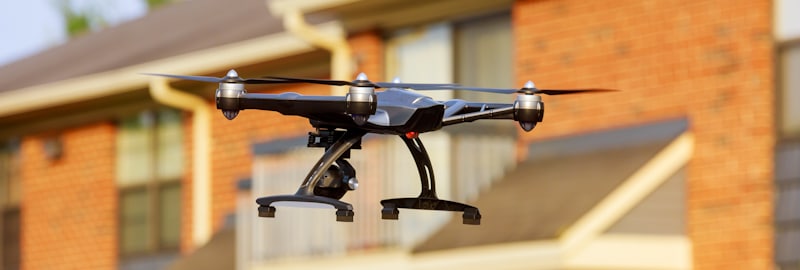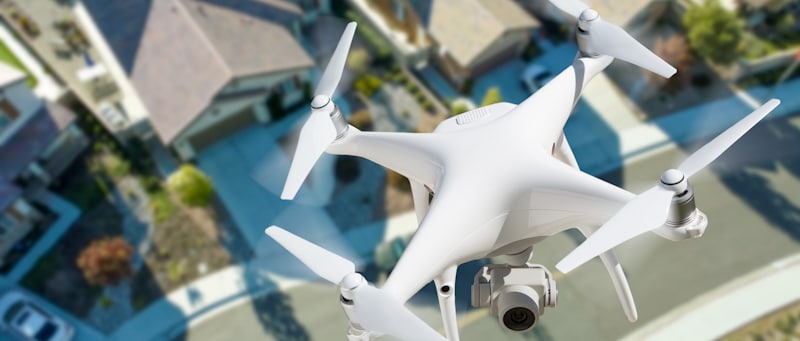For many people, drone flying has grown to be a significant hobby. It is for more than just people who enjoy flying things that can be operated remotely. Even though flying a drone may be cool, there are several limitations and factors you should be aware of when deciding where to fly it. You might be asking if flying a drone within your backyard is acceptable.
Drones are legal to fly in backyards and on other private property. However, you can only do this if your neighborhood is not a no-fly region or otherwise governed by local laws. Additionally, you must confirm that you adhere to all other drone flying laws.
Even while flying drones may appear to be a safe pastime, you should be aware that there are a variety of implications and potential risks associated with it. Due to the potential harm to other people's safety and well-being when using a drone, there are strict regulations on their use.

Where Can I Fly My Drone
Airspace that is not subject to the supervision of air traffic control, or the uncontrolled portion of airspace, is where you are permitted to fly. No-fly orders may be issued for specific stretches of airspace either temporarily or permanently. You are not permitted to fly near airports or above crowds. To fly over regions of reserved nature, you need to have a permit.
Drones can fly over a lot of the US without encountering any regulatory issues. Outside of the restricted area near airports, most Class G airspace normally allows drones to operate.
Additionally, you can fly nearer to airports by submitting a brief online application through one of the many available, no-cost apps that interact with the FAA.
Your backyard is among the first locations to test out your drone. You can operate it anywhere between 50 and under 400 feet once you get used to directing it. The FAA refers to this as Class G Airspace, and as long as you keep inside certain bounds, you are permitted to fly over your land.
Bring your drone along if you enjoy being on the water. You are prepared to go if you want to go kayaking, engage in some water sports, or take pictures of the shoreline as dusk falls. Just be mindful that some river segments may enter Class B-controlled airspace because of their closeness to an airport or port.
Any area controlled by the National Park Service is off-limits to drone use. This prohibits using a National Park for takeoff, landing, or flying through. The ban aims to have as little impact as possible on natural, historical, and cultural resources.
Can You Fly A Drone In Your Backyard
The thing to remember about flying a drone is that it could take some training to learn how to do it safely. This indicates that the steep curve necessitates that you practice operating the drone by yourself, preferably at home.
The most sensible option is to learn to fly a drone inside your backyard because most drones are unsafe to fly indoors. However, there are restrictions on what you can accomplish with drone flying, another component of drone flying that needs to be recognized.
There are several locations where drones are prohibited for safety and security purposes. You should be aware of the whereabouts of these forbidden areas or whether your garden is one of them. Before responding to that question, you must consider several elements because the outcome depends on them.
However, the answer is yes; you can operate a drone within your backyard. Under normal conditions, you ought to be able to operate a drone in your backyard instead of being concerned about breaking any rules or regulations.
The main caveat to that response would be that you can only utilize your backyard to operate a drone if and only if neither any zoning limitations apply to you. Regrettably, you will not be able to operate a drone in your backyard when there are limitations that exist in the location where your property is located, especially if we are referring to your backyard.
It is among the most frequent restrictions in this circumstance if you reside in a region designated as a no-fly area for one factor or another. This is an excellent illustration of a no-fly zone if you reside close to a power plant, an airport, or a military post.
The reasons you should not fly a drone in these places should be rather obvious; doing so poses some safety and security issues. Therefore, even though your backyard is on your private land, if you do reside in a no-fly zone, you are not permitted to operate your drone there.
The threats to safety and security exceed your right to operate a drone on your personal property; thus, if any drone flying limitations relate to you and your area, you will not be allowed to operate your drone completely at will.
A home that is on fire nearby or the necessity for emergency services in your region are two more circumstances that would restrict your capacity to operate your drone in your garden. Flying in such situations would be risky for everyone concerned.

Can I Fly A Drone In My Neighborhood
You can fly drones in your community, backyard, home, and even in your neighbors' homes. Use caution when using your drone to avoid bothering or eavesdropping on the neighbors, as doing so can be against the law.
You should operate your drone around your house as you get more drone training by flying in your yard. After all, it is your property. As we advised, you will be alright if you adhere to the FAA's regulations.
Flying around your land will eventually get monotonous. You are trying to find something novel. Can you operate the UAV in your area and broaden your drone's legal operating range? You certainly can. The FAA, which sets regulations for all types of flights, including drone flights, governs airspace higher than 400 feet.
You can fly anywhere in uncontrolled airspace, including everything below that. Some local and state regulations may attempt to forbid neighborhood drone use; being a federal entity, the FAA takes precedence over any local or state laws. That does not imply you can operate without the chance of receiving a penalty.
Although state and legal regulations might be unable to prevent your drone from flying, you are normally prohibited from acting in a way that would distress or harm others. It is frequently considered harassment to fly near bystanders who only go about their daily lives on your street.
Your neighborhood's people have a right to be out without a drone flying too close and annoying. You will be in trouble if they report you to the authorities. It is forbidden to use your drone to follow people, either up close or more obtrusively, or to eavesdrop on them.
When using a drone to spy on someone, you might view them via an open window, utilize your drone's camera to record them as they leave their house or even attempt to fly your drone into their house. Never fly your drone so close to someone else that you risk hurting them.
The propellers on UAVs are just one of several working components that can be exceedingly dangerous to people. It can do significant harm whenever a drone moves quickly, even with propeller guards.
Final Thoughts
Local rules in certain cities and municipalities forbid operating a drone within your backyard or neighborhood. If you need clarification about the regulations in your town or city, you can contact the town or district hall to learn more about them. However, you are usually permitted to operate on your property.
Shawn Manaher loves to play with new toys and dive into new hobbies. As a serial entrepreneur, work definitely comes first but there is always room for hobbies.

![Can You Fly A Drone In Your Backyard? [IS IT WORTH IT?]](https://hobbynation.net/wp-content/uploads/2022/11/can-you-fly-a-drone-in-your-backyard-728x410.jpg)